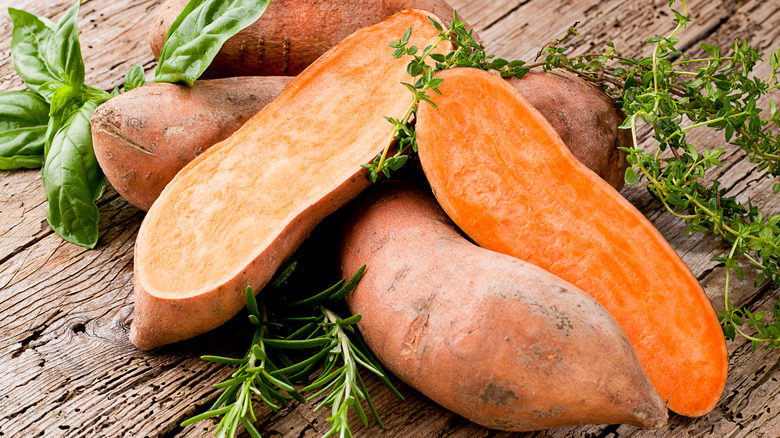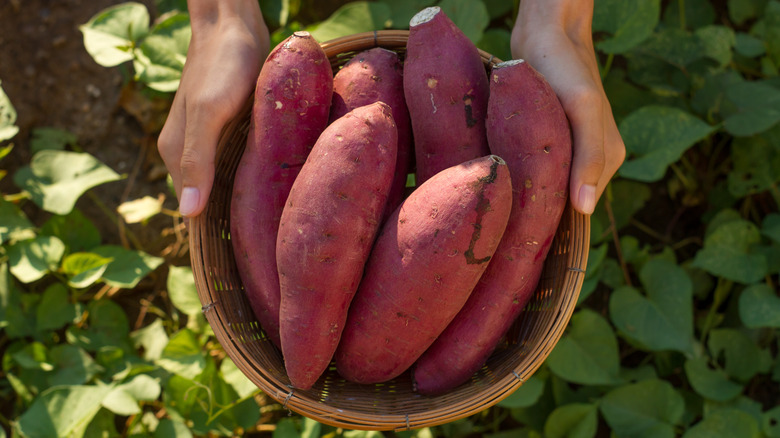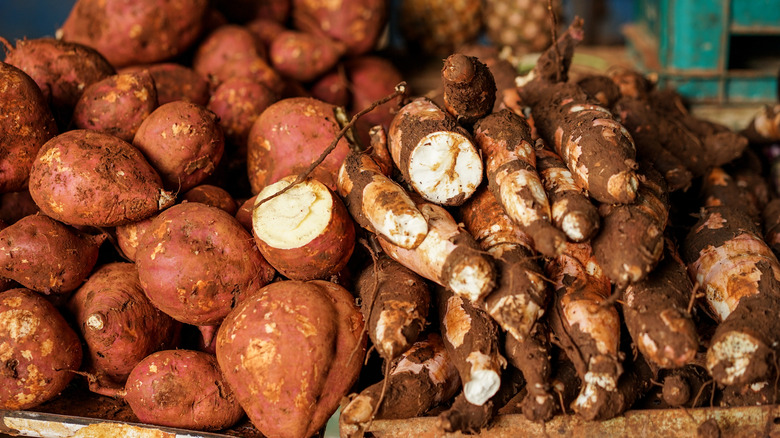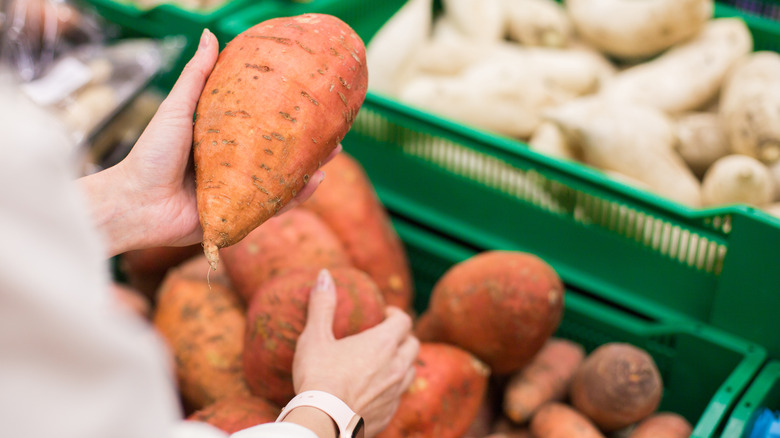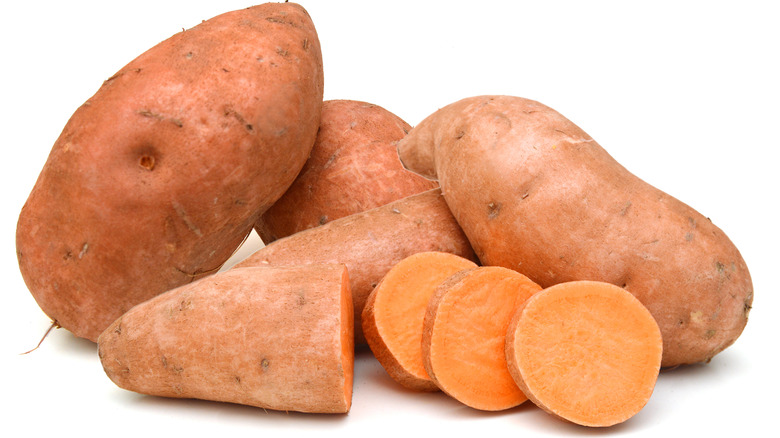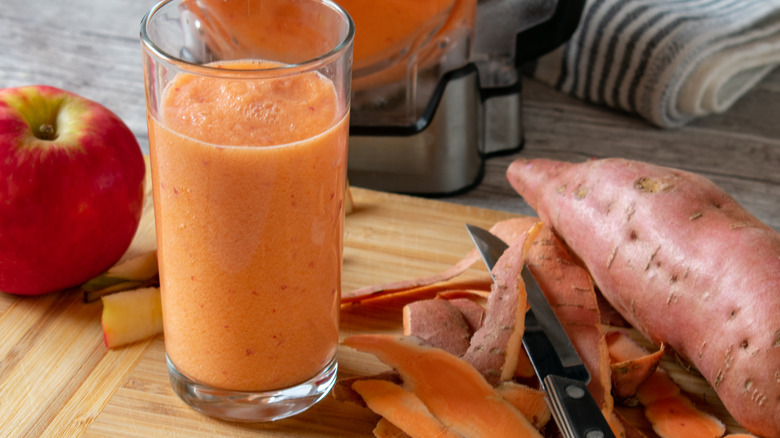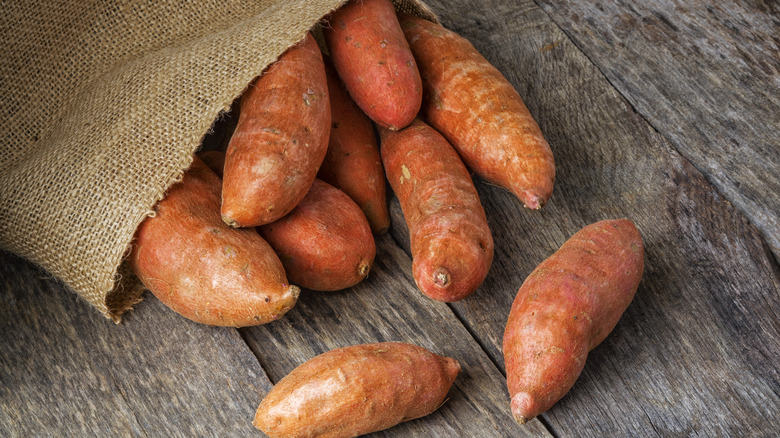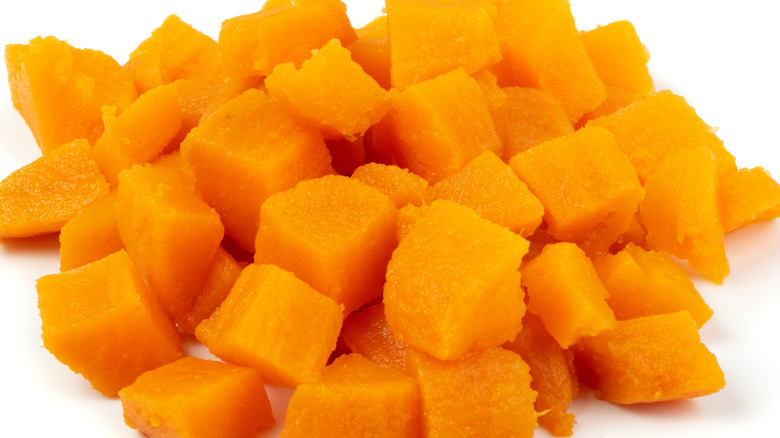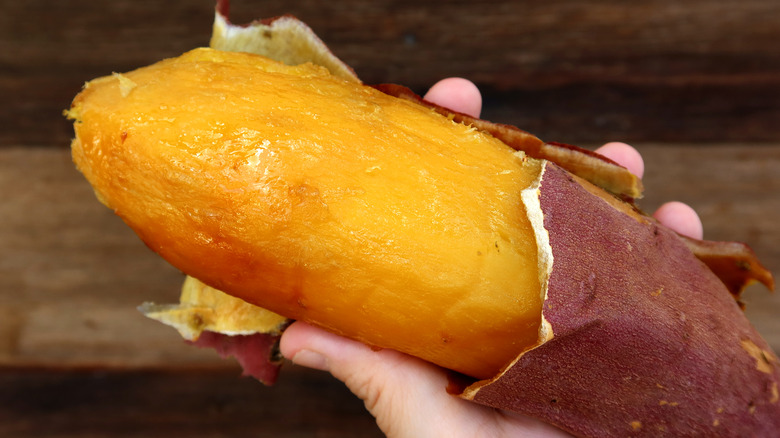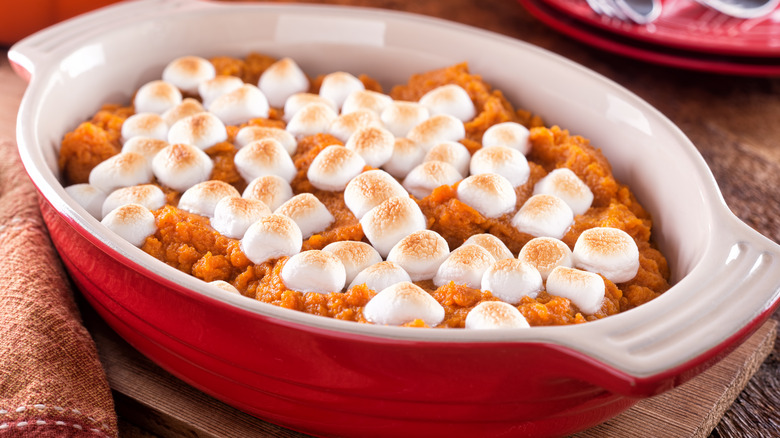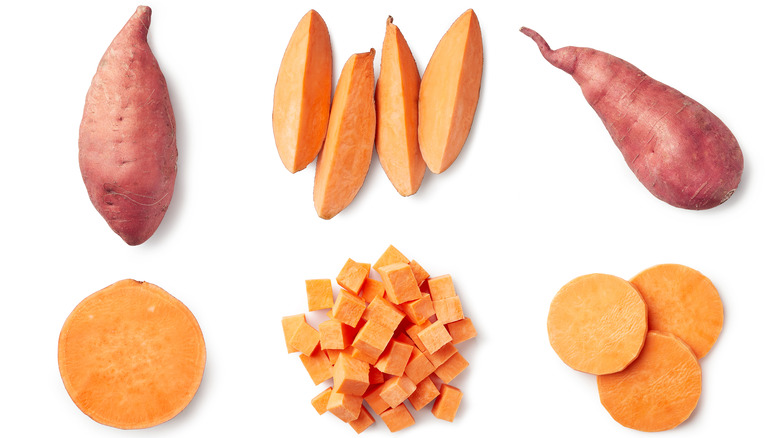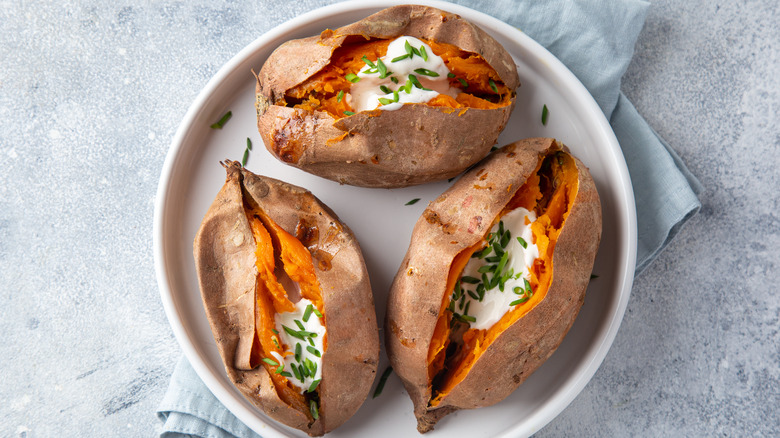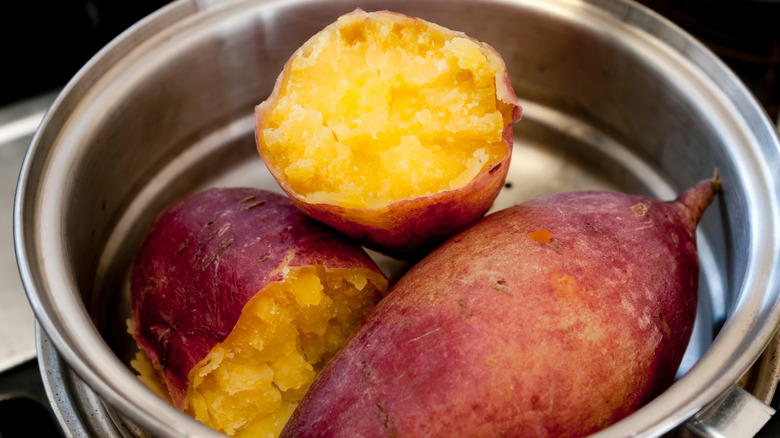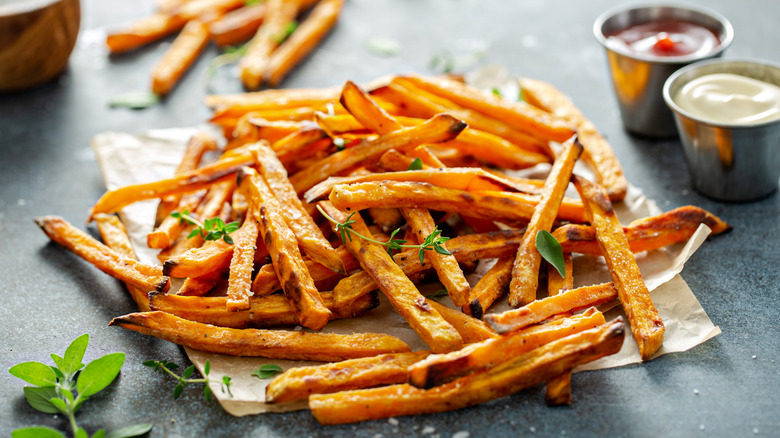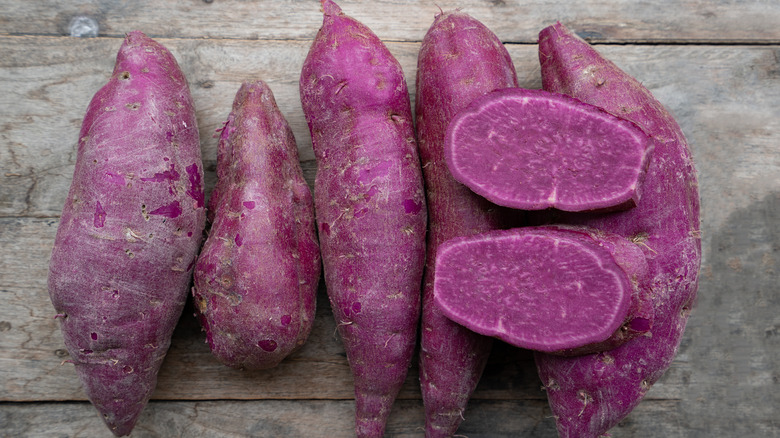12 Sweet Potato Hacks You'll Wish You Knew Sooner
Belonging to the morning glory family, sweet potatoes are not potatoes. They're actually root vegetables known for their distinctly sweet flavor, especially when cooked in ways that enhance this nutritious vegetable. Consumed by Peruvians as early as 750 B.C., there are hundreds of different varieties of sweet potatoes grown around the world today (via WebMD). The most commonly consumed sweet potato found in grocery stores in the United States is the Beauregard sweet potato, and the bright orange center of the vegetable is typically all that's eaten (via Washington Post). However, in some countries, it's common to eat the sweet potato leaves and shoots as well as the root (via Harvard). Rich in beta-carotene, which are naturally-occurring phytochemicals, sweet potatoes are considered a nutritious and delicious way to improve your health. Some traditional practitioners have even used sweet potatoes as a natural healing method for intestinal parasites.
Because sweet potatoes are so common and popular at the store, they get used in a lot of ways in the kitchen. There are some mistakes you can make with sweet potatoes that should be avoided, as well as some serious hacks that will have you rooting for this root vegetable from here on out. So keep reading to reap the most rewards from your next craving for sweet potatoes.
Grow your own sweet potatoes
One way to incorporate more sweet potatoes into your diet is by adding them to your garden, or starting one with sweet potatoes, so you can have easy access to this nutritious root vegetable. And it's easier to get started than you might think. With the right environment of quality soil and bright sunlight, HGTV suggests starting with a vining type of sweet potato that is clean and healthy to produce your slips. A single sweet potato can produce up to 50 sprouts. In order to create them, simply need to cut your potato into large sections and position it with toothpicks into a jar of water with half the potato submerged. Keep it warm in the light of a windowsill and allow the sprouts to grow for several weeks, at which point you'll be ready to plant them.
According to Homes and Gardens, you'll want to give your sprouted cuts plenty of room to breathe and grow in their slips. If growing them outdoors, make sure it's warm with plenty of light. If you live in a cooler region, you may want to protect your garden inside a greenhouse. Your homegrown sweet potatoes will be ready to eat after a few months of water, sun, and care.
Don't let the grocery store fool you
One of the most common misconceptions when it comes to sweet potatoes is thinking they are the same thing as yams. The Washington Post reports that it's very unlikely you've actually seen, let alone tried, a true yam in the United States. For the most part, they're mislabeled in the supermarket and thus are considered basically interchangeable, but in truth, yams are much different in flavor and texture than their more common counterpart, the sweet potato. Even though you think a yam might be similar in color on the outside, as well as a vibrant orange center, you need to dismiss everything you think you know about a yam. A yam is actually a tubular vegetable more closely related to a potato, and it resembles russets, with white flesh and rough brown skin (via Mississippi State University).
The real reason you're being duped by your local grocery store? The root of that story dates back to the 1930s when farmers needed a new way to market the new orange-fleshed sweet potatoes from the white-centered versions they had been selling, so they called them yams and it stuck.
Buy sweet potatoes when they are in season
It's no coincidence that sweet potatoes go hand in hand with a fall or winter holiday spread, as they are best when in season from September through early winter (via The Washington Post). Although they are available year-round in the United States, sweet potatoes truly are at their most tasty when consumed during the cold weather months, giving them time to be developed and harvested during their peak season in early fall (via FoodPrint).
Fall is also the best time to harvest sweet potatoes fresh from your own garden, with September or early October the most fruitful months to harvest. However, it takes time to cure them in proper storage in order to develop their signature texture and sweetness. And that means that right around Thanksgiving through December is the ultimate time to bust out a sweet potato casserole recipe. When stored correctly, sweet potatoes you've harvested and cured from your garden will last for months.
Bigger isn't better when shopping for sweet potatoes
When selecting a sweet potato from your grocery store, you want to look for a few signs to make sure you're purchasing the freshest, most recently harvested produce available to you. The Washington Post suggests checking the sweet potato for any bruises or soft spots as you want your sweet potato to have smooth, sprout-free skin that's firm to the touch. It's also best to choose smaller sweet potatoes as opposed to some of the monster vegetables you might see in your supermarket, as they can be difficult to chop and contain more starch and less juice than the smaller ones.
Once you've selected the best produce, you'll want to give your veggies a good rinse, soaking them if there are lots of soil particles present, and gently scrub with a vegetable scrubber if needed, so you can ensure you don't taste dirt or consume pesticides when devouring your finished dish.
Juice sweet potatoes for the most nutritional benefits
The process of juicing produce removes the fiber, while extracting all the vital nutrients and minerals from vegetables or fruits, making sweet potatoes a nutritional powerhouse when juiced (via the Mayo Clinic). The end result is a milky smooth drink with a hint of sweetness that is a versatile match with any other combination of fruits or veggies (via The Juice Chief).
When juicing, you'll want to be sure and select firm sweet potatoes that don't show signs of softness or bruising. Leaving them raw and skin-on will ensure the most beneficial enzymes and nutrients are extracted from your juiced sweet potatoes. With an abundance of Vitamins A, B, and C, consuming sweet potato juice as part of a routine healthy diet may reduce the risk of certain types of cancer, as well as combat diabetes and heart disease (via WebMD). Sweet potatoes are also high in potassium, which may help reduce muscle cramps, lower stress levels, and improve digestive health.
Store raw sweet potatoes correctly
Proper food storage is always the best way to increase shelf life and get the best bang for your buck, and storing your sweet potatoes using the right method will help to achieve both. When you first purchase your sweet potato and bring it home, the best way to store it is on your countertop in a dark space that remains cool. But that doesn't necessarily mean the fridge. Sweet potatoes will change their cellular makeup when stored in the refrigerator, per the North Carolina Sweet Potato Commission. It's also worth noting that you should keep them away from your onions and garlic, as this will make your sweet potatoes sprout faster (via Southern Living).
If you've prepped too many portions and need to store raw, chopped sweet potatoes, you may place them in a bath of cold water and then keep them in an airtight container in the fridge for up to four days. If you won't be needing them for a while, blanch them first, then put them in a sealed bag in the freezer where they should stay food for up to six months. Be sure to follow our tips for blanching vegetables to get the best results.
Make your cooked sweet potatoes last for several meals
Once you've cooked your sweet potatoes, you can still make them last quite a long time if you follow a few simple steps. Masterclass says to peel and slice the cooked and cooled sweet potatoes, and then place the rounds in a single layer on to a baking sheet lined with parchment paper. Freeze the slices overnight, then transfer them to a sealed bag and put them back in the freezer for up to a year. You can also freeze mashed sweet potatoes by adding a squeeze of lemon juice to prevent them from browning. If you're going to eat your cooked sweet potatoes within a few days, it's best to store them in an airtight container in the refrigerator, whether roasted, boiled, or mashed. Otherwise, these can go in the freezer as well.
No matter what method you choose, the most important rule for storing sweet potatoes is to wait for them to cool to room temperature before transferring the potato to any type of container in order to prevent them from becoming mushy (via Pantry & Larder).
When possible, don't peel your sweet potatoes
Peeling or not peeling your sweet potato largely depends on the recipe you're following, as well as your cooking technique. But when in doubt, leaving the peel on is the healthiest option. That's because sweet potato peels contain a lot of nutrients like fiber and potassium. According to Healthline, the vitamins and minerals that are found in many fruits and vegetables, like sweet potatoes, are more dense closer to the skin as opposed to the center, so peeling them can severely impact the true health benefits of certain produce. But remember that the key to eating the skin is to make sure you thoroughly rinse and scrub the sweet potato beforehand to remove any dirt and chemicals.
Should your recipe call for a peeled sweet potato, Southern Living suggests roasting them in the oven prior to peeling them. When cooked thoroughly, the skins should fall away from the sweet potato without even needing to use a peeler. The technique of rolling and peeling back the skin after roasting it will ensure the neatest and most flavorful outcome.
Add eggs to sweet potato casserole
Holiday dinners would not be the same without a sweet potato casserole, but with so many rich and heavy options on the Thanksgiving or Christmas menu, a lighter casserole dish may be the key ingredient to your holiday meal. Adding an egg is the hack everyone needs to try in order to make a light and fluffy sweet potato casserole, per The Healthy Toast. One large beaten egg is all that is needed to give your sweet potato casserole structure while keeping it moist and fluffy.
An egg is also an easy way to fix common mistakes with sweet potato casserole. For example, if your casserole is too thin and watery, adding a whisked egg with a pinch of flour will be just the thickener to fix the dish (via Eating Expired). If your sweet potato casserole ends up coming out too dense, an egg is once again the ingredient that comes to the rescue. With so many heavy ingredients like milk, butter, syrup, or sugar included in sweet potato casserole recipes, a whipped egg is the perfect way to avoid a side dish that is too much to handle.
Cut your sweet potatoes for even cooking
Whether you're making roasted wedges, sweet potato fries, or boiling sweet potatoes to mash or sautee, you'll want to cut them into as even sections as possible so that they are consistently cooked, no matter the time and temperature, and have an even texture, no matter what dish you're preparing (via Food Network).
According to Cutco, there is a specific set of instructions to properly cut a sweet potato into equal portions. Using a large chef knife, first cut the sweet potato in half lengthwise. Using a flat service, lay the two sides cut-side down and slice them evenly into long strips. You can then take it a step further and cut the strips horizontally into cubes before boiling or roasting them. One last tip to achieve even cooking and consistency in your sweet potatoes is to be sure to coat the wedges or cubes in olive oil or your cooking oil of choice on all sides, and to season them evenly as well.
Bake sweet potatoes for a mess-free option
There really doesn't seem to be any wrong method for cooking a sweet potato. However, baking them whole with the skin on is definitely one of the most mess-free, consistent ways to cook and peel a sweet potato, and it's one of the most commonly used methods, according to the Food Network. One important tip to remember when baking your sweet potatoes is to pierce them a few times through the skin before placing them in the oven to allow them to steam and cook more evenly.
If you have time to chop your sweet potato into cubes, roasting the pieces on a sheet pan is another great option and will give you more control of the flavor, as you can season each cube evenly. With just a little bit of extra effort and a few more ingredients, try making some loaded baked sweet potatoes to compliment any holiday gathering or cozy winter meal. Our recipe for oven roasted sweet potatoes only takes six ingredients and half an hour. You can even make it more simple with this recipe for 15-minute loaded sweet potatoes.
Boil or steam sweet potatoes for the healthiest result
Boiling is another popular method for cooking sweet potatoes. But steaming them will give you similar results, and may be a better option if you're looking to maximize the nutritional benefits of this healthy root vegetable. If you're short on time, steaming is also faster than baking, and can be a versatile option, as having steamed sweet potatoes on hand will help elevate any rice, pasta, or side dish. Whether you're boiling or steaming your sweet potatoes, Better Homes and Gardens suggests not overcrowding your saucepan or dutch oven, as this will prevent the cubes from steaming evenly.
If you have some time, but want to avoid the fuss, Better Homes and Gardens also recommends tossing a few evenly chopped pieces in the slower cooker. As a last resort, there's always the microwave too, which gets the job done in minimal time — though the results may be unevenly cooked potato bites. But if you're hungry and in a hurry, it's a sacrifice worth making.
Fry sweet potatoes for a crowd-pleasing side dish
Whether making sweet potatoes fries or air frying the veggie, whole or cubed, frying is a method that is sure to please your taste buds. For sweet potato fries that aren't actually deep fried, cut your sweet potatoes into even sticks and place them on a parchment paper-lined baking sheet in the oven. You can follow our easy recipe for crispy fries every time. A few simple seasonings go al long way to turn your sweet potatoes into the guiltless french fries you may be craving. But the one seasoning you don't need to use with your sweet potato fries is a sweetener, because why would you sweeten something that nature has already made perfectly sweet? To make your sweet potato fries crispy like they came out of a restaurant fryer rather than your home oven, try soaking them in water and patting them dry to remove excess starch.
Another hack for crispy sweet potatoes is to cook them in the air fryer, leaving the oven or stove free to cook your meat or other side dishes. The air fryer method is also a faster cooking technique than the oven, and according to airfrying.net, cooking them in the air fryer will nearly cut the time in half.
Don't treat all sweet potato varieties the same
Not all sweet potato varieties match every cooking technique or recipe, but there are some common qualities about each to help guide you. Per the Sustained Kitchen, Beauregard and Jewel sweet potatoes are the most commonly found varieties in the United States, and therefore tend to be the most commonly called for in dishes that showcase the sweeter side of sweet potatoes rather than the savory. But there's a whole world of other sweet potatoes out there.
The Washington Post reports that garnet sweet potatoes (often called garnet yams in grocery store aisles) are more moist than the aforementioned two varieties, and are recognizable by their dark reddish-purple skin, making them a great option for baking that won't result in a dry final product. Okinawa sweet potatoes are known for their dark purple center and starchy texture. Their aesthetic appeal and density make them a stellar choice for stews. And Hannah sweet potatoes are another unique variety known for their white center and light skin. They're also less sweet than any other variety, making them a fit choice for a nutritional French fry (via Sustained Kitchen).
